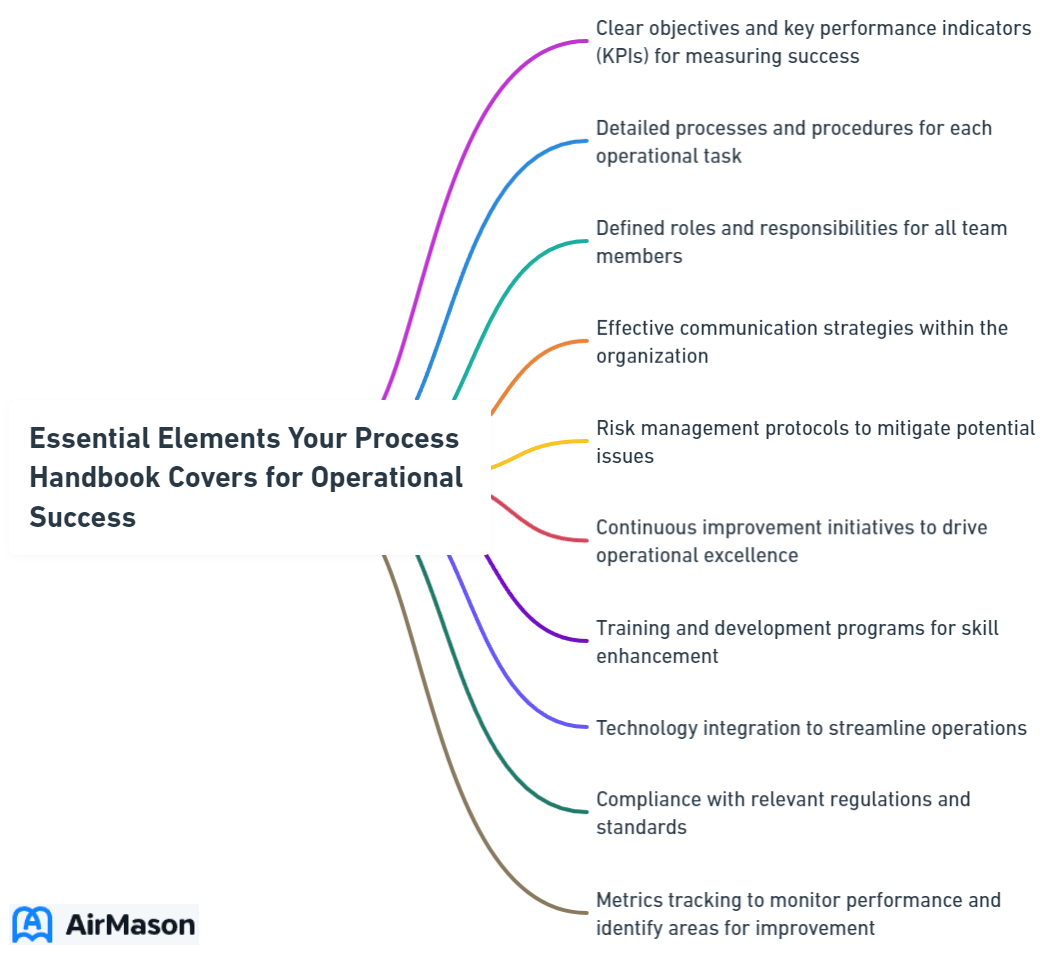
Navigating operational processes can be daunting; that’s where well-crafted process handbook covers come in. They lay out a roadmap for consistency and performance. This article highlights key features your handbook must cover, ensuring your teams operate like a well-oiled machine, without revealing the inner workings just yet.
Key Takeaways
- A comprehensive process handbook details complex organizational operations, ensuring efficient and effective task execution, and requires clear documentation, identification of essential resources, and establishment of detailed procedures and guidelines.
- The structure of a process handbook includes core processes and workflows, defined roles and responsibilities, and performance metrics for evaluation, each playing a critical role in the functionality and operational success of the organization.
- Effective implementation of a process handbook involves customization to company-specific needs, integrating it into employee training and onboarding, and encouraging continuous review and adaptation with the aid of technology and feedback mechanisms.
Employee Handbook Disclaimer
The “Employee Handbook Disclaimer” serves as a crucial component of our company’s policies and guidelines. This disclaimer outlines the terms and conditions regarding the usage and interpretation of the information contained within our employee handbook. It’s important to note that while we strive to ensure the accuracy and relevance of the content provided, situations and regulations may change over time. Therefore, this disclaimer acts as a safeguard, indicating that the handbook’s contents are subject to updates and revisions as deemed necessary by the company. By acknowledging this disclaimer, employees recognize the dynamic nature of our policies and agree to adhere to the most current versions available.
Defining the Scope of a Comprehensive Process Handbook

A comprehensive process handbook is more than a mere repository of rules and regulations; it is an extensive guide that meticulously records each step in complex processes and tasks. It translates the intricate operations of an organization into an understandable language, enabling employees to perform tasks efficiently and effectively.
A process handbook serves essentially as a compass, directing employees and ensuring adherence to established guidelines.
The Essence of Process Documentation
Process documentation is akin to creating a map of a complex labyrinth. It captures every twist and turn, providing a comprehensive guide for employees to navigate their tasks. From inputs and outputs to process steps, it meticulously documents all the essential components, ensuring smooth operations.
Nonetheless, obstacles like unauthorized content changes or loss of important documents are inevitable in any process. With the aid of tools like checklists and screenshots, these difficulties can be tackled, ensuring a clear path for your employees.

Identifying Necessary Tools and Resources
Envisage embarking on a journey without the necessary tools. Similarly, for crafting a process handbook, clear objectives, step-by-step guides, and documentation tools like Nuclino and Lucidchart are indispensable. These tools serve as the building blocks, helping employees perform tasks efficiently and effectively.
Templates and forms further streamline this process by ensuring structure, consistency, and standardization in the documentation process.
Establishing Clear Procedures and Guidelines
Clear procedures and guidelines are the roadmap for your employees. They direct each step, minimizing confusion and errors, and ensuring tasks are executed in a uniform and efficient manner. From establishing clear brand identity to outlining internal rules and policies, these guidelines act as the pillars, holding up the structure of your organization.
As roads and routes modify over time, it is vital that your procedures and guidelines also evolve to mirror the current landscape of your business.
The Anatomy of a Process Handbook

The anatomy of a process handbook is as intricate as the human body, with each element playing a crucial role in its functionality. From the core processes and workflows that form the backbone to the roles, responsibilities, and duties that represent the limbs, each component is crucial for the handbook’s operation.
Performance metrics and evaluation act as the pulse for the process handbook, much like how the human body assesses its functions through vital signs, reflecting its health and efficiency.
Core Processes and Workflows
Core processes and workflows are the skeletal structure of a process handbook, providing a systematic approach to task execution. They help identify the vital organs of your organization, the processes that are essential for scalability and stability. Be it sales order workflow in sales sector or document verification and approval workflow in customer support, these workflows ensure that your organization functions smoothly.
Task execution, akin to the muscles that animate the skeleton, plays a pivotal role in melding these core processes and workflows.
Roles, Responsibilities, and Duties
Roles, responsibilities, and duties are the limbs of a process handbook, performing specific tasks to ensure the smooth operation of the organization. These elements, clearly defined in the handbook, ensure that each employee knows their unique role, reducing confusion and promoting efficiency.
Organizations, much like a body experiencing aches and pains, can encounter challenges due to ambiguities in roles and responsibilities. Addressing these issues can facilitate smooth and effective operations within your organization.
Performance Metrics and Evaluation
Performance metrics and evaluation are the vital signs of a process handbook, monitoring its health and effectiveness. These metrics, akin to a doctor’s diagnostic tests, assess the effectiveness of the handbook by evaluating the overall organizational performance and progress towards goals.
These metrics provide a holistic view of your organization’s health, gauging everything from efficiency to productivity, thus ensuring a fit and robust organization.
Core Mark Employee Handbook
The Core Mark Employee Handbook serves as a comprehensive guide for all employees, outlining company policies, procedures, and expectations. Within this handbook, you will find valuable information regarding workplace conduct, benefits, and professional development opportunities. It is essential for all employees to familiarize themselves with the contents of the Core Mark Employee Handbook to ensure a harmonious and productive work environment. Compliance with the guidelines outlined in the handbook is mandatory for all staff members to maintain the integrity and success of our organization.
Implementation Strategies for Maximum Efficiency

Implementing a process handbook is like embarking on a journey. You must prepare by understanding your unique needs, train for the journey ahead, and be ready to adapt to the changing landscapes. With every journey being unique, so too must the process handbook be customized to align with the specific needs of your company, mirroring its unique business processes and workflows.
Tailoring to Company-Specific Needs
Just as a tailor adjusts a suit to fit perfectly, a process handbook must be customized to fit the specific needs of a company. This involves:
- Incorporating the unique processes and workflows of the organization
- Considering the organizational structure and hierarchy
- Taking into account any industry-specific regulations that may impact the business.
Just as a tailor relies on client measurements and feedback, it becomes imperative to garner employee feedback to ensure the handbook aptly fits the company.
Training and Onboarding with the Handbook
The process handbook is a powerful training tool, much like a workout regime for your employees. Just as a fitness trainer would introduce a new workout routine, integrating the process handbook into the new employee onboarding experience ensures that they are equipped with the necessary knowledge and skills from the get-go.
As a trainer ensures correct adherence to a routine, it becomes critical to make certain that employees comprehend and interact effectively with the process handbook.
Continuous Review and Adaptation
A process handbook, much like a river that changes its course, is not a static document. It must undergo continuous review and adaptation to mirror the business’s evolving landscape. This process is akin to a health check-up, where regular assessments are conducted to ensure that the handbook remains fit and healthy.
It involves gathering feedback from staff, monitoring process performance, and making necessary updates to the documentation.
Leveraging Technology to Enhance Handbook Usage

Technology, akin to a compass that aids navigation, can significantly augment the usage of a process handbook. Digital access and intranet integration can swiftly and efficiently lead employees to the information they require. Moreover, interactive elements and multimedia resources can make the journey more engaging, like a tour guide who brings a location to life with stories and facts.
Finally, feedback mechanisms allow for continuous improvement of the handbook, ensuring that it remains relevant and useful for all users.
Digital Access and Intranet Integration
In the contemporary digital era, access to information is paramount. Digital access and intranet integration, much like a compass pointing north, direct employees to the information they seek. However, just as a compass needs to be protected from interference to maintain accuracy, companies must implement measures to ensure that the digital access to their process handbook is secure.
Interactive Elements and Multimedia Resources
Interactive elements and multimedia resources, akin to attractions on a journey, render the trip more engaging and memorable. These resources, such as videos, quizzes, and interactive flowcharts, can enhance the learning experience, just as a fascinating landmark can make a journey more enjoyable.
Feedback Mechanisms for Continuous Improvement
Feedback mechanisms, much like signposts on a journey, aid in guiding the way and enriching the experience. These mechanisms, such as performance measurement and employee feedback initiatives, allow organizations to gather real-time insights and make necessary adjustments, just as a traveler might adjust their course based on the signs they encounter.
Real-World Applications and Case Studies

The real measure of a process handbook lies in its real-world application. Case studies across various industries offer insights into the actual implementation of process handbooks, highlighting their benefits and effectiveness. These stories serve as proof of the handbook’s potential to transform operations and enhance efficiency, just as a successful journey demonstrates the value of a good map.
Success Stories in Various Industries
Process handbooks have demonstrated their value across sectors, from manufacturing to healthcare, by sustaining operational efficiency and boosting service quality. These success stories act as a source of inspiration, illustrating how process handbooks can be customized to address the distinct needs and challenges of different industries.
Lessons Learned from Implementation Challenges
The implementation of process handbooks, much like every journey, presents its own set of challenges. However, these obstacles are not setbacks but opportunities for learning and growth. Addressing these issues and drawing insights from previous hurdles can facilitate a smoother implementation journey for organizations.
How Much Does an Employee Handbook Cost
“How much does an employee handbook cost?” is a common question among businesses of all sizes. The cost of creating an employee handbook can vary significantly depending on several factors such as the complexity of the content, the size of the organization, and whether you hire a professional to help develop it. Generally, the cost can range from a few hundred to several thousand dollars. DIY options may be more affordable, but hiring a professional ensures thoroughness and compliance with legal standards. Investing in a well-crafted employee handbook is essential for setting clear expectations and protecting your company from potential legal issues.
Measuring the Impact on Organizational Success
Much like the success of a journey is gauged not only by the destination but also the experiences gathered en route, the success of a process handbook can be measured by its influence on enhancing efficiency, productivity, and service quality.
By gauging the performance metrics and evaluating the effectiveness of the handbook, organizations can gain valuable insights into their operational success.
Summary
In the labyrinth of organizational operations, a comprehensive process handbook serves as a crucial map, illuminating the path to operational success. By understanding its anatomy, implementing it efficiently, leveraging technology, and learning from real-world applications, organizations can navigate the complex maze of operations with ease. Remember, your process handbook is not just a document; it’s a compass guiding your journey towards operational excellence.
Frequently Asked Questions
What process handbook covers?
A process handbook covers essential information about a specific process in an organization, including documentation, standardization procedures, step-by-step instructions, workflows, and key performance indicators.
What is included in an employee handbook?
An employee handbook typically includes information about employees’ rights, employment relationships, code of conduct, company policies, and expectations. It serves as a guide for employees regarding the company’s policies and expectations.
How does technology enhance the usage of a process handbook?
Technology enhances the usage of a process handbook by providing digital access, intranet integration, interactive elements, and feedback mechanisms, which make it more user-friendly and engaging.
How can a process handbook be tailored to meet the specific needs of a company?
A process handbook can be tailored to meet the specific needs of a company by incorporating unique processes and workflows, considering the organizational structure, and gathering feedback from employees. This ensures that the handbook aligns with the company’s practices and goals.
How is the success of a process handbook measured?
The success of a process handbook is measured through performance metrics like efficiency, productivity, and service quality, which are assessed regularly to gauge its impact on organizational success.
Important Disclaimer:
Please be aware that the content on this page has been generated by using artificial intelligence language models and may contain errors, inconsistencies, or outdated information. It is provided as-is without any warranties or guarantees of accuracy.
We strongly recommend using this content as a starting point for further research. We disclaim any liability for damages or losses resulting from the use or reliance on this content.